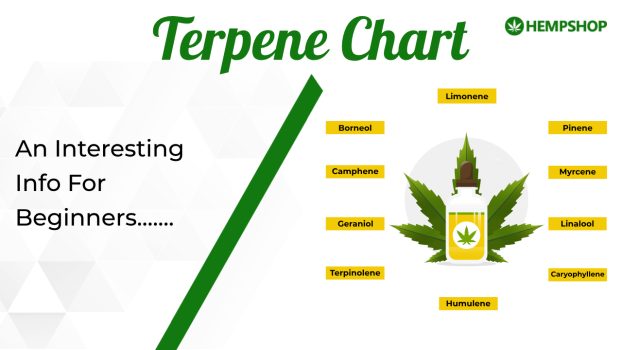What are Terpenes?
Terpenes are aromatic compounds found in cannabis and various other plants, playing a significant role in shaping the unique aroma and effects of different cannabis strains. Understanding these terpenes can help beginners navigate the diverse world of cannabis and make informed choices based on their preferences and desired experiences. In this guide, we present a cannabis terpenes chart and brief explanations to introduce newcomers to the fascinating world of cannabis terpenes.
What is a Terpenes Chart?
A terpene chart is a visual guide that shows the different types of terpenes found in cannabis and other plants, along with their properties and effects. Terpene charts can be used to choose the right cannabis strain for your needs, understand the flavor and aroma of different strains, and learn about the potential benefits of terpenes.
Terpenes Charts Typically Include Information About the Following:
- Terpene name: The name of the terpene, such as limonene, myrcene, or pinene.
- Aroma: The aroma of the terpene, which can be described as citrusy, piney, woody, or floral.
- Flavor: The flavor of the terpene, which can be described as sweet, sour, bitter, or spicy.
- Effects: The potential effects of the terpene, such as relaxing, uplifting, or energizing.
| Terpene | Aroma | Found in | Potential Benefits |
|---|---|---|---|
| Limonene | Citrus, lemony | Citrus fruits, juniper, rosemary | Elevates mood, reduces stress |
| Pinene | Pine, fresh | Pine needles, rosemary, sage | Anti-inflammatory, respiratory support |
| Myrcene | Herbal, fruity | Hops, thyme, mangoes | Sedative, potential analgesic |
| Linalool | Floral, sweet | Lavender, jasmine, lilac | Calming, relaxing |
| Caryophyllene | Spicy, woody | Black pepper, cloves, hops | Anti-inflammatory, potential analgesic |
| Humulene | Earthy, woody | Hops, coriander, basil | Anti-bacterial, anti-inflammatory |
| Terpinolene | Floral, herbal | Lilacs, nutmeg, cumin | Sedative, antioxidant |
| Geraniol | Rose-like, fruity | Roses, geraniums, lemongrass | Potential anti-anxiety, antioxidant |
| Camphene | Camphor, herbal | Camphor, fennel, nutmeg | Potential respiratory benefits |
| Borneol | Minty, camphor | Mint, rosemary, sage | Analgesic, potential anti-inflammatory |
Guide for Beginners
- Explore Aromas: Smell different cannabis strains to identify the dominant aromas. Terpenes significantly contribute to the scent profiles, helping you discover your preferred aromas.
- Understand Effects: Learn how each terpene may influence the cannabis experience. For instance, myrcene-rich strains are often chosen for relaxation, while limonene-rich strains may offer an uplifting and invigorating experience.
- Consider Personal Goals: Determine your cannabis goals, whether it's relaxation, focus, or stress relief. Match terpene profiles to align with your desired effects.
- Start Slow: As a beginner, start with small doses and gradually increase to assess how different terpenes affect you personally.
- Seek Lab Testing: Look for cannabis products with lab-tested terpene profiles to ensure accuracy and consistency.
- Experiment: Don't be afraid to explore various strains and terpene combinations to find what works best for you.
FAQ's
The most common terpene in the world is Myrcene. It is found in various plants, including cannabis, hops, lemongrass, and mangoes.
Limonene is the terpene associated with energy. It is commonly found in citrus fruits like lemons, oranges, and grapefruits, known for its uplifting and energizing effects.
Linalool is the terpene often associated with happiness. It is found in lavender, jasmine, and other flowers, and is used in aromatherapy for its calming and mood-enhancing properties.
Cannabis (marijuana) plants have some of the highest terpene content among commonly known plants. Different strains of cannabis can contain various terpenes, contributing to their distinct aromas and effects.
Myrcene is known for its sedating and calming properties. It is found in high concentrations in hops and is responsible for the relaxing effects of certain cannabis strains, as well as being associated with a “couch-lock” feeling in some users.
One interesting fact about terpenes is that they are not exclusive to plants; they are also found in some insects, contributing to their distinctive scents. For example, ants and bees produce terpenes to communicate with their colonies, creating a unique aromatic language that helps coordinate their activities.
One interesting fact about terpenes is that they are not exclusive to plants; they are also found in some insects, contributing to their distinctive scents. For example, ants and bees produce terpenes to communicate with their colonies, creating a unique aromatic language that helps coordinate their activities.








